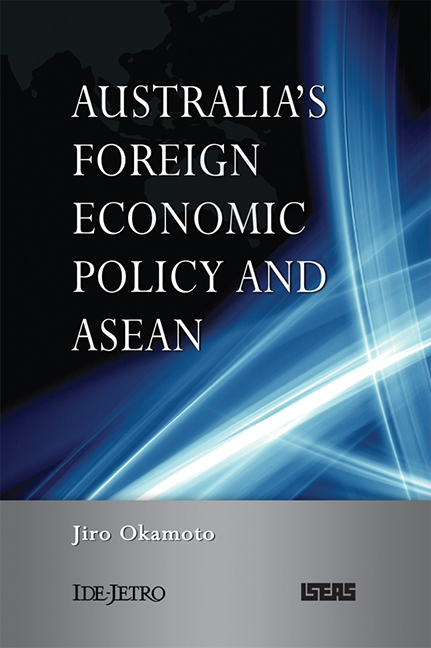Book contents
- Frontmatter
- Contents
- List of Figures and Tables
- Abbreviations and Acronyms
- Acknowledgements
- 1 Introduction
- 2 An Analytical Framework
- 3 State-Society Coalitions and Australia's Foreign Economic Policy
- 4 Australia and the Formation of ASEAN
- 5 The Trade Liberalizers and Asia-Pacific Regionalist Strategies
- 6 The Development of ASEAN Regionalism and the AFTA–CER Linkage Dialogue
- 7 The Bilateralists and their ASEAN Policy
- 8 Conclusion
- Appendix: Foreign Economic Policy-Related Ministers in Australia since 1941
- References
- Index
- About the Author
4 - Australia and the Formation of ASEAN
Published online by Cambridge University Press: 21 October 2015
- Frontmatter
- Contents
- List of Figures and Tables
- Abbreviations and Acronyms
- Acknowledgements
- 1 Introduction
- 2 An Analytical Framework
- 3 State-Society Coalitions and Australia's Foreign Economic Policy
- 4 Australia and the Formation of ASEAN
- 5 The Trade Liberalizers and Asia-Pacific Regionalist Strategies
- 6 The Development of ASEAN Regionalism and the AFTA–CER Linkage Dialogue
- 7 The Bilateralists and their ASEAN Policy
- 8 Conclusion
- Appendix: Foreign Economic Policy-Related Ministers in Australia since 1941
- References
- Index
- About the Author
Summary
The foreign economic policy stance of the Australian Government (and the protectionist coalition) towards Southeast Asia in the post-war period was in essence contradictory. On the one hand, Southeast Asia has always been a strategically important region for Australia because of its geographical proximity. This was etched in Australian consciousness by the Japanese invasion of Southeast Asia during the Pacific War (Waters 1997, p. 42). Its importance intensified soon after the war: the end of the war meant the gradual end of colonial rule by European powers and the foundation of independent countries in the region. Under these circumstances, political and security considerations imbued Australia's relations with the Southeast Asian region with great significance. Australia supported the economic development of these newly independent countries. Economic development of these countries was thought to be the key to achieving stability in the region and to strengthening countervailing power against communist penetration. On the other hand, World War II had strengthened the policy idea of the protectionist coalition. Australia accepted the non discrimination and MFN principles and became an original member of the GATT. Yet Australia secured the right to maintain tariffs for protective purposes in the mid-1950s.
Assisting the economic development of newly independent countries in Southeast Asia and, at the same time, maintaining high levels of protection and assistance for Australia's domestic industries were potentially mutually exclusive tasks. When these new countries developed sufficient industrial capacity to export their products (most likely to be labour-intensive manufactured products given their relative abundance in labour over other resources), it was at least to some extent inevitable that they would demand that Australia open up its markets to their exports. This contradiction in foreign policy stance did not matter much until the 1970s because the competitiveness of the Southeast Asian economies remained limited and their trade was mainly dominated by primary commodities. The fact that most of the newly independent countries in the region struggled in their nation building in the early period and had conflicts with each other did not provide favourable conditions for economic development.
- Type
- Chapter
- Information
- Australia's Foreign Economic Policy and ASEAN , pp. 96 - 131Publisher: ISEAS–Yusof Ishak InstitutePrint publication year: 2010

